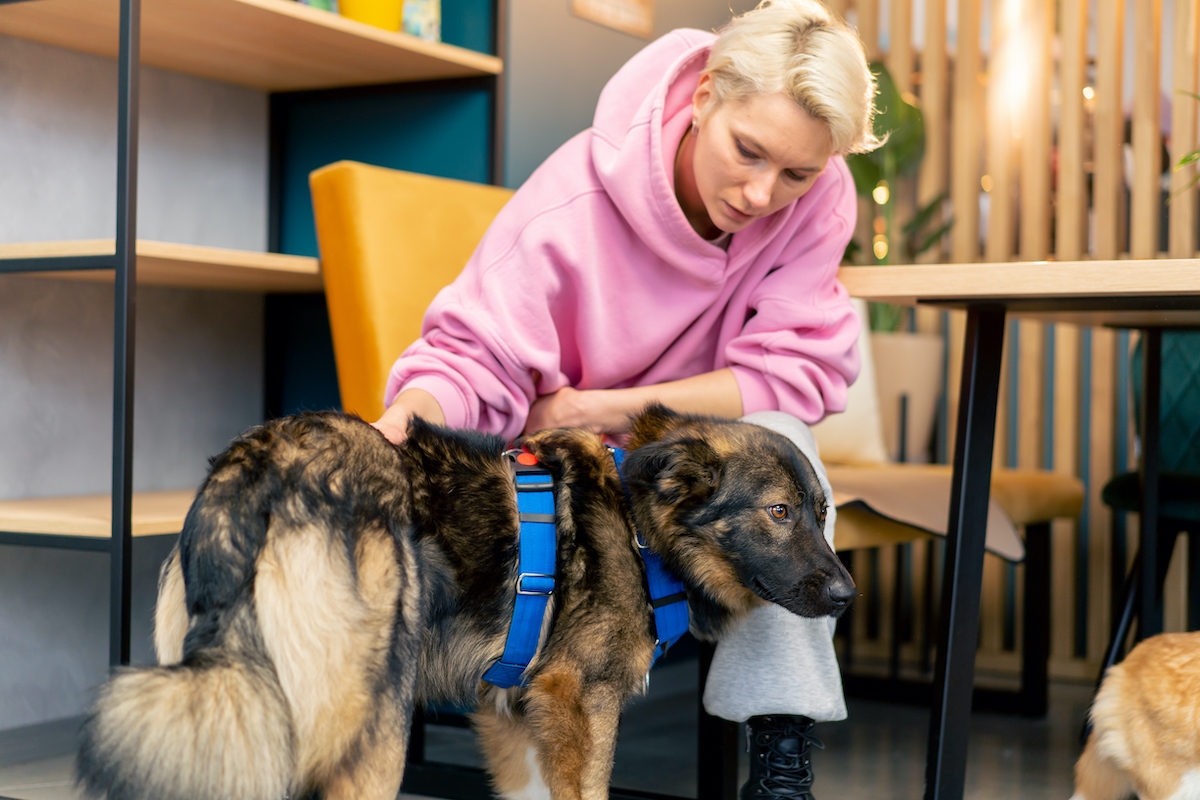Therapy Dog Training

Our Therapy Dog Training Could Help:
- Those managing chronic pain
- People looking to increase social interaction
- Anyone seeking enhanced motivation and purpose
- Individuals in need of emotional comfort
- Those experiencing stress, anxiety, or depression
- People wanting to boost overall optimism
- Anyone feeling lonely or isolated
What is a Therapy
Dog?
A therapy dog is trained to provide emotional support and comfort to people in need, often visiting places like hospitals, nursing homes, and schools. These dogs must be friendly with strangers, remain calm in distracting environments, and respect personal boundaries—such as not jumping, licking, or mouthing. With the right training, therapy dogs bring joy and emotional relief to those they interact with, offering companionship in stressful settings.
At Lasting Dog Training, we offer programs designed to help your dog become a certified therapy dog. Our focus is on developing the right temperament and essential skills so your dog can confidently provide comfort and emotional support in a variety of environments. With our expert guidance, your dog can become a trusted source of care and connection for individuals in need.
Unlock Exclusive Dog
Training Insights
Sign up with your email to receive exclusive tips, special offers, and expert dog training advice.

Get In Touch
How Does a Dog Become a
Therapy Dog?
- While the companionship your dog provides may inspire you to share that joy with others, not every dog is naturally suited for therapy work. In addition to having a friendly and loving personality, there are several important qualifications a dog must meet to be considered for therapy training:
Read More
- Age: Puppies are usually too energetic and lack the maturity and focus needed for therapy work.
- Obedience: A reliable response to commands is essential. Dogs that have completed basic obedience training with Lasting Dog Training will have a strong foundation to begin therapy dog training.
- Social Skills: Therapy dogs should genuinely enjoy meeting new people and remain calm when being petted or approached by strangers. Their ability to stay composed and friendly in unfamiliar settings is key to providing emotional support effectively.

Hear From Our
Customers

Sarah M., Los Angeles
Absolutely incredible training! My dog went from anxious and reactive to calm and obedient. The trainers are patient, knowledgeable, and truly care about your pet’s success

James R., Beverly Hills
I tried multiple trainers before, but nothing compares to this program. My dog walks perfectly on a leash now and responds to all commands. Life-changing!

Sarah M., Los Angeles
Best decision I made for my pup! The personalized approach made all the difference, and now my dog listens like a pro. Highly recommend

Benefits of Therapy Dogs
Dogs
Therapy dogs have a powerful and lasting impact on emotional and physical well-being. Studies show that therapy dogs can lift moods, reduce stress levels, and even help manage pain during medical treatments or hospital stays. Their calming presence offers comfort and support during life’s most difficult moments.
Read More
Children, in particular, often respond positively to therapy dogs. The playful companionship of a therapy dog can encourage kids to participate more fully in therapy or treatment, helping them feel safer, more optimistic, and less anxious.
Outside of medical environments, therapy dogs can greatly enhance social interaction—especially for individuals in the autism and mental health communities. These dogs provide non-judgmental companionship and help build social bridges for those who may struggle with connection. By easing loneliness and reducing anxiety, therapy dogs bring comfort and joy, enriching lives in a deeply meaningful way.
Therapy Dog Handlers
- If you’ve ever wanted to make a meaningful difference in the lives of others, becoming a therapy dog handler offers a rewarding way to do so—side by side with your dog. You’ll have the flexibility to volunteer in settings that align with your passions, such as schools, hospitals, or senior care facilities.
Read More


Why Choose Lasting Dog
Training
At Lasting Dog Training, our therapy dog programs are designed to prepare your dog for real-world environments where their presence can truly make a difference. We go beyond basic obedience to ensure your dog is comfortable and confident in emotionally charged or stimulating settings like hospitals, schools, and care facilities.
Read More
Our training emphasizes socialization, adaptability, and emotional awareness—key traits that make therapy dogs effective and dependable. We help your dog build the confidence to interact positively with people of all ages and backgrounds. With a focus on trust, consistency, and patience, we lay the groundwork for your dog to become a calm, compassionate companion ready to offer comfort and connection wherever it’s needed.
Educate, Empower, Elevate, Elite
Victory Begins With Elite Education
What’s the
Difference?
Animals that offer assistance and companionship typically fall into three categories: service animals, emotional support animals (ESAs), and therapy animals. Each serves a unique purpose and comes with its own training requirements and legal distinctions. Understanding the differences can help you determine which type of support animal best fits your needs—whether for a disability, emotional well-being, or therapy-related work.
Here’s a breakdown of the key characteristics of each:
Service Animals
Service animals are trained to help individuals by performing tasks that meet their specific needs, such as:
- Redirecting attention when an individual is beginning to feel overstimulated
- Reminding owners to take medication
- Waking someone who is having a nightmare
Service dogs are highly valued in the mental health and disability community and are protected under ADA laws, allowing them to accompany their owners anywhere. At DTE, we provide specialized training for service dogs that assist individuals with autism, diabetes, and PTSD.
The key difference between ESAs, therapy dogs, and service dogs is that service animals are protected by the Americans with Disabilities Act. This means they are allowed to go anywhere their owner goes. ESAs and therapy dogs do not have the same protections as service dogs, and public places can set their own rules about allowing them.
